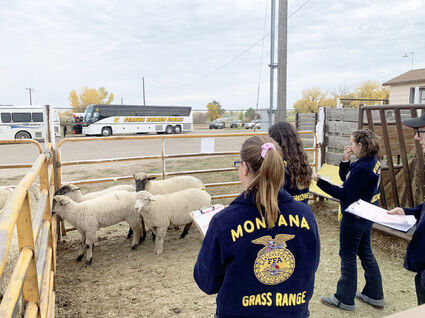Chinook FFA Chapter Hosts District Contest
October 13, 2021

Shipwheel Cattle Company provided the young bulls and fat cattle (fats) for the FFA Livestock Judging Contests, while Max Hofeldt brought three classes of sheep: market lambs, white-faced rams, and black-faced rams. A number of the Judith Basin District Fall Contest events took place at the Bear Paw Livestock facility, making the event a community collaboration.
The Chinook Chapter of the FFA hosted Judith Basin District's Fall Contest on Wednesday, October 6 with several livestock judging events taking place at the Bear Paw Livestock facility in Chinook and with range contests occurring at the Chinook Rod and Gun Club range site. Chinook High School Agriculture Education Instructor and FFA Advisor, Karyn Billmayer reported that there was a good turnout and beautiful weather for the event. Approximately 230 students competed in livestock judging and another 45 took on the challenge with range management.
Of the eight FFA districts into which the state is divided, the Judith Basin District encompasses communities across Montana's Northern Tier-often called the Hi-Line-and several as far south as Grass Range and Judith Gap. Of those, Billmayer stated that seventeen Chapters originally registered for the District Contest but only 15 actually showed up with teams. FFA members from Roy, Denton, Winifred, Harlem, Lewistown, Malta, Stanford, Hobson, Fort Benton, Geraldine, Grass Range, Judith Gap, Big Sandy, and Moore joined Chinook competitors.
After Winifred officials run the Scantron, the scores revealed will determine which teams advance to State FFA Convention in March. Scores were still being tabulated as of Friday, October 8.
Chinook FFA had eleven members judging livestock. In the senior division, Morgan Friede, Torin Cecrle, Bree Swanson, and Wylee Simenson competed. Representing Chinook in the junior division were Gus Buck, Neva Lowe, Emma Klingaman, Kenneth Gruszie, Falyn Cecrle, Griffen Crowley, and Britt Powell.
For the livestock judging, Shipwheel Cattle Company provided the young bulls and fat cattle (fats), while Max Hofeldt brought three classes of sheep: market lambs, white-faced rams, and black-faced rams.
Finding livestock was a challenge, according to Billmayer. "We didn't have any pigs, for example, because of disease risk considerations and the timing of the contest. Many producers have already shipped their animals to fall markets."
In judging the livestock, students worked in teams to rank breeding and market classes of beef and sheep, then gave oral reasons to support their decisions. While there is no rubric or standard score card, competitors looked for factors related to body structure and genetics.
Billmayer indicated that these student judges practice with their FFA advisors and learn the terms and techniques for evaluating animals. Terms such as level hipped, broodier, or roach topped identify traits in livestock. For example, roach topped refers to the arch of the back and is an undesirable trait in steers, heifers, and bulls. Students participating in this Career Development Event (CDE) come to understand what makes a good market or breeding beef, swine, or sheep. Because every livestock producer has to make decisions regarding desirable traits and to select and market livestock that will satisfy consumer demands as well as provide increased economic returns to producers, this CDE imparts valuable experience.
"A lot of the judging refers to the animal's structure or foundation-whether their body has the bone structure to hold the weight you're putting on a market animal or for supporting pregnancy in a breeding animal," Billmayer explained. "Students also judge for good genetics and confirmation, a term which refers to an animal's being evenly balanced in the shoulder, mid-section, and hind end or rump."
The stations in livestock judging also included tool identification. Here, students identified instruments used in doctoring or processing livestock.
Since students must also give oral reasons for their rankings, this CDE encourages them to communicate proficiently, interpret data, and work as a team - skills that translate into other career opportunities.
Although Chinook did not have any competitors in Range Management, those competing encountered five different stations: Plant Identification, Plant Anatomy, Ecological Sites Description, Degree of Utilization, and Stocking Rates. In the first, competitors were required not only to identify 20 plants from a list of 130 but also to indicate something about the plant's type, life span, season of growth, grazing response, origin, and ecological and resource rating for food-whether it is poisonous or noxious or neither.
In the second, they examined ten different plant mounts, naming such features as leaf shape, root system, and various plant parts.
At the Ecological Sites Description station, contestants worked with a pre-dug soil pit. Using a dichotomous key, they keyed out such features as soil type (i.e. shallow, irrigated) and composition (i.e. clay, lime) while evaluating the resource for range conditions to sustain livestock.
Referring to the proportion of a current year's forage production that is consumed or destroyed by animals, the next station, Degree of Utilization involves looking at a plot to determine grazing availability. Proper utilization or use is an assessment of the current year's growth that, if continued, will achieve management objectives and maintain or improve the long-term productivity of the site. Students had to determine whether a grazing system is working and to make recommendations based on stubble height, plants that require monitoring, and species composition for healthy grazing land. After all, a proper grazing system should increase stocking rates.
By learning which plants make productive forage plants; which are unpalatable, undesirable, and less productive species; and whether they are decreasers, increasers, or invaders, students can determine how to best manage grazing land for livestock. Economically, the amount of forage affects cash flow.
Finally, the Stocking Rates station presented a scenario about a rancher's field. Contestants used charts to key out acres and Animal Unit Months (AUM) to determine how many animals can graze and for how long.
Most contests finished by early afternoon, and Billmayer was relieved that her "first ever" experience at hosting a contest as an FFA Advisor went smoothly. "I couldn't have done this without all of the community's help, however. So, I wish to thank everyone who helped to make this happen-from the producers who brought in livestock to the organizations who contributed space for the contests-as well as the numerous others who made contributions with time and talent. It was a team effort, and I am so appreciative."








